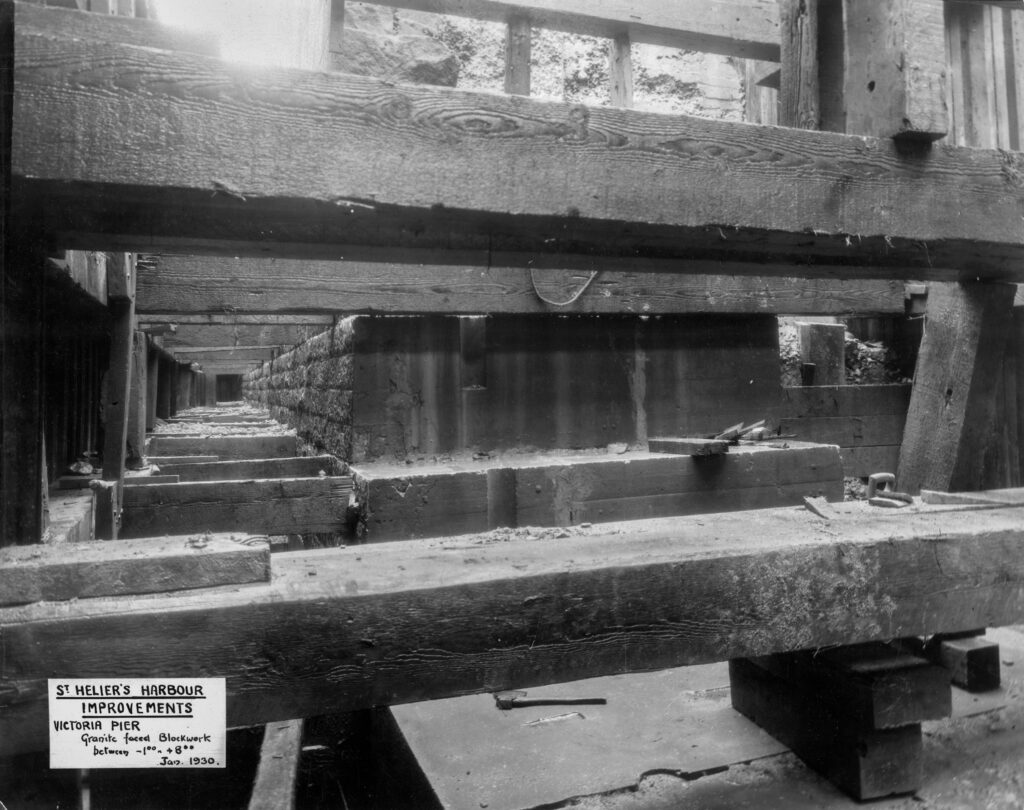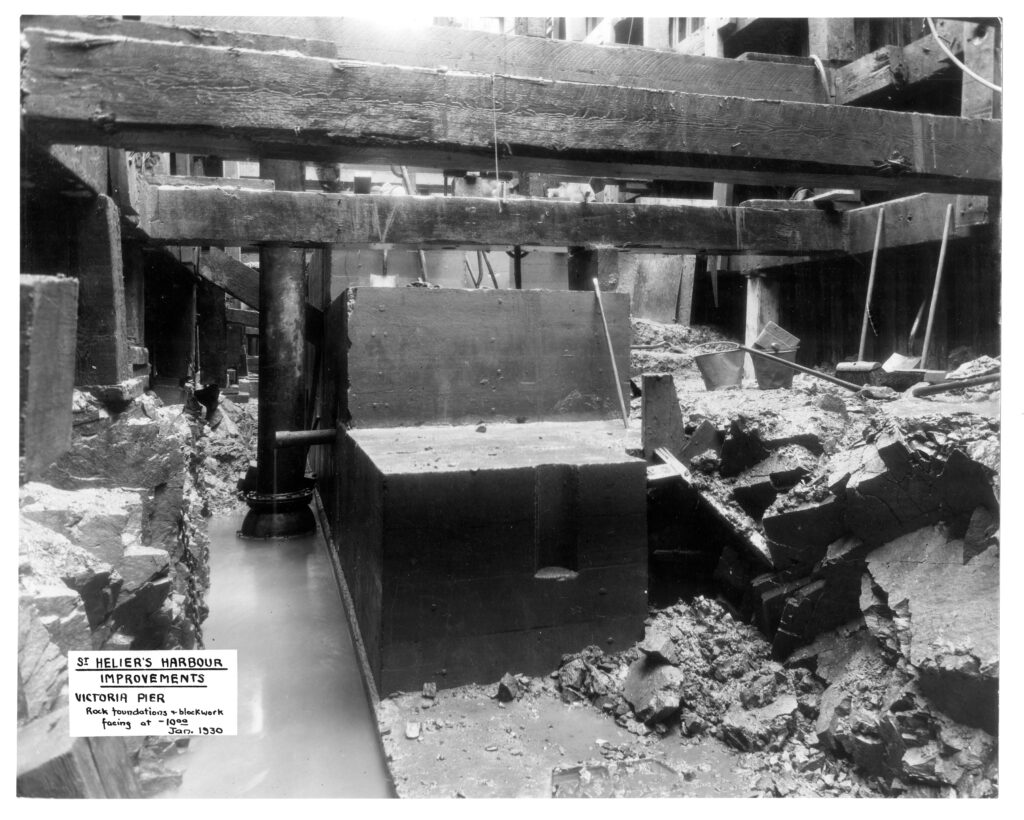ED.EM.04
Pour les communautés insulaires, leurs ports et leurs quais ont une importance symbolique et pratique évidente. Ils facilitent le commerce et la communication, et quand l’économie d’une île se développe au-delà de ses ressources, ils en viennent à symboliser la survie et les opportunités.
Pendant une bonne partie du 20e siècle, le bateau postal et les ferries accostaient le long du quai Albert, où les êtres chers se disaient au revoir et où ils étaient accueillis à leur retour. Le quai Victoria continue de servir à des fins commerciales, accueillant de petits services de fret et des bateaux de pêche. Il a nourri des vies et des entreprises pendant près de deux siècles.
Les quais ont été adaptés au fur et à mesure de l’évolution des besoins, et les travaux se poursuivent. Geomarine a commencé en 2021 la construction des postes d’amarrage en eau profonde pour les yachts au large du quai Albert et la rénovation des pontons de la marina de Saint Hélier. Comme toujours, les changements reflètent l’île de l’époque et ils ne seront pas les derniers car les quais continuent de servir notre communauté insulaire.
For island communities, their ports and piers hold symbolic as well as obvious practical significance. They facilitate trade and communication, as an islands economy grows beyond the means by which it can support itself, they come to symbolise survival and possibility.
For much of the 20th Century the mailboat and ferries berthed along Albert pier, it was the point at which loved ones were kissed goodbye and welcomed home as they disembarked. Victoria continues to serve commercial ends, receiving small freight services and fishing boats, it has nursed livelihoods and businesses for approaching two centuries.
The piers have been adapted as needs have changed, this process is ongoing. During 2021 Geomarine has started constructing deep water berths for yachts off Albert Pier and renovating the pontoons in St Helier Marina. As always, the changes reflect the island at the time, they will not be the last these piers see, as they continue to serve our island community.



















Victoria and Albert:
on the piers
MAR2022
ISSN 2633-5093
Editors – Martin Toft & Patrick Cahill
Text – Doug Ford
Printed by Park Communications
200x140mm, 48pp self-cover zine
With thanks to Valérie Noël, Judy Smith, Alan Richomme, and Shan O’Donnell.
Special thanks to the featured contemporary photographers: Darren Sowney, Fenby Miskin, Max Burnett and Martin Toft. As well as our sponsor Garenne Construction Group.
Make your own:
Local maritime historian Alec Podger passed away in 2021, he produced numerous articles and talks on Jersey’s maritime history, including a history of St Helier harbours up to 1800. This issue is dedicated to Alec, in recognition of his work.
Victoria and Albert:
a harbour for the modern age
Doug Ford
It could be said that Jersey entered the modern age on the morning of Wednesday, 11 June 1823, when the Isle of Wight based paddle-steamer Medina entered St Helier harbour. She had been chartered to travel over to Guernsey, where she was met with such interest that her commander, Captain Knight, spotted a commercial opportunity and advertised a day trip to Jersey and sold 133 tickets before returning to Southampton on the Thursday evening. Mechanically driven travel had arrived – timings were no longer subject to the vagaries of the weather.
This technological advance also coincided with a dramatic rise in the population of the Island in the period immediately following the Napoleonic Wars. Between 1821 and 1851, the number of people living on the Island effectively doubled from 28,600 to just over 57,000. At the same time, there was a dramatic increase in both domestic and international trade and this was reflected in the rise of the Jersey merchant fleet.
In the 1820s, St Helier harbour consisted of the English and French harbours enclosed by South Pier and the North Quay, which all dried out. The owners of the new steamships and the larger sailing vessels were not keen on their vessels taking the ground and the merchants wanted somewhere for vessels to lie alongside in order to load and unload regardless of the tidal situation.
In 1836 the Chamber of Commerce invited one of Britain’s leading civil engineers, James Walker, to prepare a report recommending how the harbour could be expanded to handle the consequent increase in maritime traffic. The report which he submitted the following year recommended that the harbour should be extended into deeper water by building two piers beyond the existing harbour. Prompted by this report, the States of Jersey passed an act to improve St Helier harbour in 1839 and passed it on to the Privy Council for Her Majesty’s approval. The work became even more important as Britain’s railway network developed and steam power opened up the potential of the Island to a new tourism trade and the export of the Island’s fresh produce to the growing urban population of England. The provision of a new harbour in which ships could be loaded and unloaded at any stage of the tide became crucial.
Construction work began to the south of the low water landing stage in the summer of 1841, and the foundation stone was laid in a rather grand ceremony on 29 September. The builders, Thomas Le Gros and Jean Gruchy completed their work on 10 August 1846 for a cost of £280,000. Three weeks later, on 2 September, Queen Victoria and Prince Albert visited Jersey and the newly constructed pier with its promenade and parapet was named after Her Majesty. Work on the second quay, to the west of the North Pier, began the following spring. The foundation stone was laid on 18 March 1847. The builders, Thomas Le Gros and Francis de la Mare, took six years to complete the work and the cost was £549,000.
It is often said that it was only named the Albert Pier because of that second Royal Visit, however, just as the first pier was named after the Queen, it was always the intention to call the second after the Prince Consort. Newspaper reports refer to it as the Albert Pier virtually from its completion. The first reference I have found referring to the pier as this comes from the Jersey Independent and Daily Telegraph of 1
September 1855 when a Mr S Lawrence is recorded as having rescued a 12 year old girl, ‘who had fallen from the Albert Pier into the sea’.
The addition of the two new piers created an outer harbour twice the size of the old harbour. However, while it didn’t dry out, it was still tidal, and ships arriving at low water still had to either wait in the ‘small roads’ until the water had risen enough to allow them to enter or else have their passengers disembark on to a smaller vessel so that they could be landed on shore. A point noted by Prince Albert during the Royal Visit of 1859 – often misquoted as saying ‘Why do you Jerseymen build harbours on dry land?’, whereas what he actually said was ‘It is very much regretted that the harbour was not so constructed as to allow a good landing in all states of the tide’.
This lack of a true deep-water harbour is what had always held back Jersey’s economic development and why envious eyes were cast over to our neighbouring isle. To achieve this, various schemes were proposed – the most adventurous being a report produced by the Admiralty in 1866 recommending that a new harbour be created to accommodate larger vessels by building a breakwater out from Elizabeth Castle and another from La Collette to enclose the Inner Roads and protect the existing harbour mouth from damaging seas in heavy weather. The scheme got underway in the summer of 1872, contractors appointed, budget approved, but work was halted following extensive damage in the winter gales of 1874/75, 1875/76 and once again in 1876/77. As The Times noted on 25 October 1873,
‘few places present greater attractions to tourists than the island of Jersey, and fewer still possess worse accommodation for landing and embarking passengers’.
Piers are never static structures, they have to change and adapt to changes in technology, business practice and passenger demand.
In 1882 the States came up with an alternative approach and decided that steamers could be allowed to enter the harbour by dredging a deep-water channel. Over the years the buildings on the piers have come and gone in response to business needs. As larger and more powerful steam vessels began pushing through the harbour mouth, remedial work had to be regularly carried out on the pier head footings. In the late 1890s, the Albert pier head had remedial work carried out on it and again in 1905, a further £40,000 was spent on ‘consolidating’ it.
About half of the images in this publication were taken during the remodelling work carried out between 1929 and 1931 largely on the Victoria Pier which saw new landing stages being added to the East and West Cross Berths and the pierhead being dismantled so that foundations could be put down into the rock in order to allow more frequent dredging. This entailed numbering each facing stone, building a cofferdam and sinking old boats loaded with stone to prevent wave damage.
It was from this slightly remodelled harbour that in June 1940 about 8,000 islanders evacuated to the mainland and the Royal Jersey Militia embarked on war service. It was here that the Red Cross ship Vega unloaded her much needed supplies in 1945 and, in the subsequent years, the harbour cranes offloaded and loaded the cargoes that contributed towards the Island’s reconstruction after five years of enemy occupation.
As a working industrial landscape, technology demanded the harbour adapt. From the 1960s, cargo that used to be handled by stevedores using cranes, barrows, hoists and hooks began to be transported in pre-packed containers. These could either be lifted or driven off ships and so in 1973 an original Bailey bridge, as used by the military, was placed on No 5 berth to accommodate the first ro/ro (roll on/roll off) ferries. This was also a boon to the tourism industry as visitors could now bring their own cars with them. To meet this demand the harbour was extended once more and by the end of the 1980s the Elizabeth Harbour had been built to handle the ro/ro traffic. The increasing use of petrol saw the unloading of fuel move to the Victoria Pier from the Folie in the 1950s and finally to a newly-built tanker berth and fuel farm on reclaimed land to the south in 1978.
Over the last 50 years the nature of St Helier harbour has changed. As commercial traffic has moved out of the more tidal areas of the eighteenth and nineteenth century harbours, they have been taken over by leisure craft, with St Helier Marina being completed in 1981, allowing the La Collette Yacht basin to provide a base for the Island’s commercial fishing fleet in 1988. As an Island community we rely heavily on our harbours; about 98% of all the food, goods and materials we use enter the Island through them. Looking at these photographs it is obvious that any work on the fabric of the piers entailed massive disruption, yet it was all done as the harbour continued to work.
Doug Ford, originally from Northumberland, has lived in Jersey since the late 1960s. He graduated from Durham University in 1974. He taught history in Jersey from 1977 until joined
Jersey Heritage in 1985, where he set up the museum learning programme. He was a member of the organisation’s management team from 1988 until he retired as Community Learning Director in 2014.
Leave a Reply